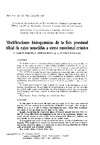Identificador persistente para citar o vincular este elemento:
https://accedacris.ulpgc.es/jspui/handle/10553/74053
| Título: | Modificaciones histoquimicas de la fisis proximal tibial de ratas sometidas a stress emocional cronico | Autores/as: | Garcés Martín, Gerardo Jiménez Díaz, Juan Fernando Ramírez González, Juan Andrés |
Clasificación UNESCO: | 310910 Cirugía | Palabras clave: | Stress Cartílago de crecimiento Rata Growth Plate Rat |
Fecha de publicación: | 1987 | Publicación seriada: | Revista española de cirugía osteoarticular | Resumen: | Se realiza un trabajo experimental con 50 ratas machos de un mes de edad. la mitad de las cuales se somete a stress crónico mediante restricción de su espacio vital. Tras ser sacrificadas al cabo de 1, 2, 4, 8 Y 12 semanas se estudió la presencia de proteoglicanos sulfatados en la fisis tibial proximal con la técnica del azul alcián.
Los resultados demuestran que desde la primera semana las ratas stressadas presentaron una escasa apetencia por el colorante azul en casi toda la fisis, salvo en los núcleos de la capa hipertrófica. Esta característica se mantuvo durante toda la experiencia. Los animales controles mostraron una gran captación inicial que fue perdiéndose progresivamente hasta ser igual a la de los stressados al cabo de doce semanas.
Se sugiere que el stress da lugar a un frenado inicial en la actividad de los condrocitos proliferativos. Su actividad va recuperándose a medida que los animales se adaptan hasta llegar a normalizarse. El tiempo transcurrido de bajo rendimiento fisario aconseja evitar esta situación en niños con problemas ortopédicos o traumatológicos. In this paper 50 one month old male rats were used. 25 of them were controled and the rest was stressed by a modification of Bonfill's technique. After being sacrificed at 1, 2, 4, 8 and 12 weeks a histochemical study (Alelan Blue technique) was made on the proximal growth pIate of the tibias. Results showed that the epiphyseal plates of stressed animals had very little avidity for Aleian Blue from the beginning to the end of the experiment. Initially controled animals showed a high avidity which progressively decreased. Staining was very similar in both groups of animals at the twelfth week. It is suggested that stress causes an initial stop in the activity of proliferative condrocytes. This progressively recovers to become normal. Due to the time of decreased activity of growth plates, it is adviceable to avoid stressing situations in children with orthopaedic and traumatic troubles. |
URI: | https://accedacris.ulpgc.es/handle/10553/74053 | ISSN: | 0304-5056 | Fuente: | Revista española de cirugía osteoarticular [ISSN 0304-5056], v. 22 (131), p. 315-320 | URL: | http://dialnet.unirioja.es/servlet/articulo?codigo=5640837 |
| Colección: | Artículos |
Visitas
114
actualizado el 01-feb-2025
Descargas
159
actualizado el 01-feb-2025
Google ScholarTM
Verifica
Comparte
Exporta metadatos
Los elementos en ULPGC accedaCRIS están protegidos por derechos de autor con todos los derechos reservados, a menos que se indique lo contrario.
